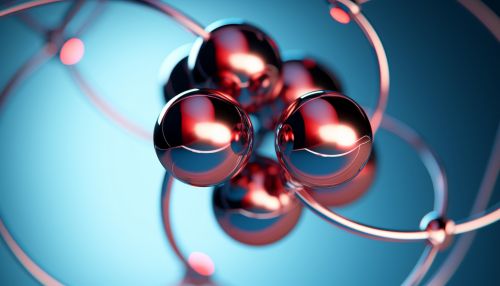Asymmetric carbon atom
Introduction
An asymmetric carbon atom, also known as a chiral carbon atom, is a carbon atom that is attached to four different types of atoms or groups of atoms. This characteristic gives rise to an interesting property known as chirality, which plays a significant role in many areas of science, particularly in the field of organic chemistry and biochemistry.


Structure and Properties
The structure of an asymmetric carbon atom is determined by the four different groups or atoms to which it is attached. These attachments can be anything from a single hydrogen atom to a complex functional group. The arrangement of these attachments in three-dimensional space gives the carbon atom its asymmetric, or chiral, nature.
The most significant property of an asymmetric carbon atom is its ability to exist in two different forms, known as stereoisomers. These forms are mirror images of each other and cannot be superimposed, much like a person's left and right hands. This property is known as chirality, and the two forms are referred to as enantiomers.
Chirality and Stereoisomers
Chirality is a property of asymmetry important in several branches of science. The word chirality is derived from the Greek 'cheir', meaning hand. Just as the human hand is chiral (the left hand is a non-superimposable mirror image of the right hand), so too are molecules that contain an asymmetric carbon atom.
Stereoisomers are isomers that differ in the spatial arrangement of atoms, rather than the order of atomic connectivity. One form of stereoisomerism is enantiomerism, where isomers are mirror images of each other, much like left and right hands. Enantiomers of a molecule with an asymmetric carbon atom are also called optical isomers, as they can rotate plane-polarized light in different directions.
Importance in Organic Chemistry and Biochemistry
Asymmetric carbon atoms play a crucial role in organic chemistry and biochemistry. Many molecules that are important for life, including amino acids, sugars, and certain hormones, contain one or more asymmetric carbon atoms. These molecules often exist in only one of the two possible enantiomeric forms. For example, all 20 of the amino acids that are common in proteins are 'left-handed', or L-amino acids, while 'right-handed' D-amino acids are rare in nature.
The presence of asymmetric carbon atoms in a molecule can also affect its reactivity and the types of reactions it can undergo. For example, the reactivity of a chiral molecule can depend on the spatial arrangement of atoms around the asymmetric carbon atom.
Conclusion
In conclusion, an asymmetric carbon atom is a carbon atom that is attached to four different types of atoms or groups of atoms. This gives rise to chirality, a property that allows the carbon atom to exist in two different forms, known as stereoisomers. Asymmetric carbon atoms play a crucial role in many areas of science, particularly in organic chemistry and biochemistry.
